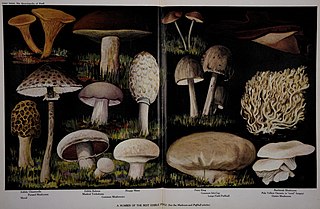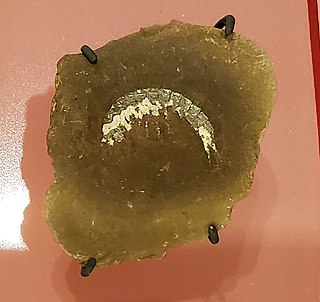
Goniurosaurus is a genus of geckos, containing 25 species. Members are known by various names including ground geckos, tiger geckos, leopard geckos, and cave geckos Members of this genus are found in China, Japan, and Vietnam. For this reason they are known commonly as Asian geckos. They belong to the family Eublepharidae.

Rhizobium is a genus of Gram-negative soil bacteria that fix nitrogen. Rhizobium species form an endosymbiotic nitrogen-fixing association with roots of (primarily) legumes and other flowering plants.

Gnetum is a genus of gymnosperms, the sole genus in the family Gnetaceae within the Gnetophyta. They are tropical evergreen trees, shrubs and lianas. Unlike other gymnosperms, they possess vessel elements in the xylem. Some species have been proposed to have been the first plants to be insect-pollinated as their fossils occur in association with extinct pollinating scorpionflies. Molecular phylogenies based on nuclear and plastid sequences from most of the species indicate hybridization among some of the Southeast Asian species. Fossil-calibrated molecular-clocks suggest that the Gnetum lineages now found in Africa, South America and Southeast Asia are the result of ancient long-distance dispersal across seawater.

Mecoptera is an order of insects in the superorder Holometabola with about six hundred species in nine families worldwide. Mecopterans are sometimes called scorpionflies after their largest family, Panorpidae, in which the males have enlarged genitals raised over the body that look similar to the stingers of scorpions, and long beaklike rostra. The Bittacidae, or hangingflies, are another prominent family and are known for their elaborate mating rituals, in which females choose mates based on the quality of gift prey offered to them by the males. A smaller group is the snow scorpionflies, family Boreidae, adults of which are sometimes seen walking on snowfields. In contrast, the majority of species in the order inhabit moist environments in tropical locations.

Entomophagy in humans or human entomophagy describes the consumption of insects (entomophagy) by humans in a cultural and biological context. The scientific term used in anthropology, cultural studies, biology and medicine is anthropo-entomophagy. Anthropo-entomophagy does not include the eating of arthropods other than insects such as arachnids and myriapods, which is defined as arachnophagy.

An edible item is any item that is safe for humans to eat. "Edible" is differentiated from "eatable" because it does not indicate how an item tastes, only whether it is fit to be eaten. Nonpoisonous items found in nature – such as some mushrooms, insects, seaweed, and so forth – are referred to as edible. Processed items that normally are not ingested but are specially manufactured to be so, like edible underwear or edible packaging, are also labeled as edible.
Michael S. Engel, FLS, FRES was an American paleontologist and entomologist, notable for contributions to insect evolutionary biology and classification. In connection with his studies he undertook field expeditions in Central Asia, Asia Minor, the Levant, Arabia, eastern Africa, the high Arctic, and South and North America, and published more than 925 papers in scientific journals.Some of Engel's research images were included in exhibitions on the aesthetic value of scientific imagery.

The scarlet skimmer or ruddy marsh skimmer, Crocothemis servilia, is a species of dragonfly of the family Libellulidae, native to east and southeast Asia and introduced to Jamaica, Florida, and Hawaii.

Osmylidae are a small family of winged insects of the net-winged insect order Neuroptera. The osmylids, also called lance lacewings, stream lacewings or giant lacewings, are found all over the world except North and Central America. There are around 225 extant species.

Escamoles, known colloquially as Mexican caviar or insect caviar, are the edible larvae and pupae of ants of the species Liometopum apiculatum and L. occidentale var. luctuosum. They are most commonly consumed in Mexico City and surrounding areas. Escamoles have been consumed in Mexico since the age of the Aztecs. The taste is described as buttery and nutty, with a texture akin to that of cottage cheese.

Lactifluus volemus, formerly known as Lactarius volemus, and commonly known as the weeping milk cap or bradley, is a species of fungus in the family Russulaceae. It is widely distributed in the northern hemisphere, in temperate regions of Europe, North America and Asia as well as some subtropical and tropical regions of Central America and Asia. A mycorrhizal fungus, its fruit bodies grow on the ground at the base of various species of trees from summer to autumn, either individually or in groups. It is valued as an edible mushroom, and is sold in markets in Asia. Several other Lactifluus mushrooms resemble L. volemus, such as the closely related edible species L. corrugis, but these can be distinguished by differences in distribution, visible morphology, and microscopic characteristics. L. volemus produces a white spore print and has roughly spherical spores about 7–8 micrometres in diameter.

Dasyleptus is an extinct genus of wingless insects in the order Archaeognatha, and the only member of the family Dasyleptidae. They resembled their modern relatives and had a single lengthy filament projecting from the end of the abdomen. They also had a pair of leg-like cerci and some non-ambulatory abdominal appendages. The largest specimens reached 30 millimetres (1.2 in) or more, not counting the length of the filament. Dasyleptus was formerly placed in its own extinct order, Monura, but this is now treated as a suborder of Archaeognatha.

Bullacta exarata, common name the Korean mud snail, is a species of a sea snail or bubble snail, a marine gastropod mollusc in the family Haminoeidae, the bubble snails.
Mei Jianjun (梅建军) is an archaeo-metallurgist. As of January 2014, he became Director of the Needham Research Institute, as well as a Fellow of Churchill College, Cambridge University. He served as President of the International Society for the History of East Asian Science, Technology and Medicine (ISHEASTM) in 2015. His book Copper and bronze metallurgy in late prehistoric Xinjiang (2001) presented "significant new archaeological data" relating to the introduction and use of copper and bronze in Xinjiang province and neighboring areas.

The Shiben or Book of Origins was an early Chinese encyclopedia which recorded imperial genealogies from the mythical Three Sovereigns and Five Emperors down to the late Spring and Autumn period, explanations of the origin of clan names, and records of legendary and historical Chinese inventors. It was written during the 2nd century BC at the time of the Han dynasty. The work was lost in the 10th century, but partially reconstructed from quotations during the Qing dynasty.

Aetalionidae are a family of treehoppers in the superfamily Membracoidea. Aetalionidae are somewhat like Membracidae in that they have one to three rows of short spines on the hind tibia but differ in having the front femur fused to the trochanter and the scutellum is completely exposed. The females have finger-like protrusions on the genital capsule. The family is mostly Neotropical. The subfamily Biturritiinae is Neotropical while the subfamily Aetalioninae has a Neotropical genus Aetalion and the sole Old World representative genus Darthula with a single species Darthula hardwickii.

Artematopodidae is a family of soft-bodied plant beetles in the superfamily Elateroidea. They are mostly found in understory forest foliage. The life history of the group is obscure, larvae of the genera Eurypogon and Macropogon likely feed on moss, while the larvae of Artematopus have been fed insect remains. The oldest fossils of the family date to the Middle Jurassic.

Wang Yinglai, also known as Ying-Lai Wang, was a Chinese biochemist recognized as the first person to create synthetic insulin, a major scientific breakthrough that produced a biologically active compound from inorganic chemicals. He was one of the first group of scientists elected to the Chinese Academy of Sciences in 1955. He founded the Shanghai Institute of Biochemistry in 1958 and served as its director until his retirement in 1984.

Mictis tenebrosa is a species of hemipteran bug found in East and South East Asia. It can also be found in parts of southern Africa. In China both the nymphs and adults are known to be edible.
















